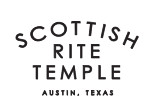WHAT IS THE SCOTTISH RITE?
The Scottish Rite is one of the two branches of Freemasonry in which a Master Mason may proceed after he has completed the three degrees of Symbolic or Blue Lodge Masonry. The other branch is known as the York Rite. The Scottish Rite has been called the “University” of Freemasonry. The Scottish Rite degrees are in addition to and are in no way “higher” than Blue Lodge degrees. Scottish Rite work amplifies and elaborates on the lessons of the Craft.
The use of the word “Scottish” has led many Masons to believe that the Rite originated in Scotland. Actually, the first reference to the Rite appears in old French records where the word “Ecossais,” meaning Scottish, is found. During the latter part of the 17th Century, when the British Isles were torn by strife, many Scots fled to France and resumed their Masonic interests is that country. It is believed that this influence contributed to the use of the word “Scottish.”
In 1732, the first “Ecossais,” or Scottish Lodge, was organized in Bordeaux, one of the oldest and most influential Masonic centers in France. The membership included Scottish and English Masons. The years 1738-40 saw the formation of the first “Hauts Grades” or advanced degrees. In 1761, certain Masonic authorities in France granted a patent to Stephen Morin of Bordeaux to carry the advanced degrees across the sea to America. In 1763, Morin established these degrees in the French possessions in the West Indies. What he established consisted of a system of 25 so-called higher degrees which flourished in France, and which were known as the “Rite of Perfection.”
Within a few years after 1763, other degrees were added, until the Rite had a ritual structure of 33 degrees — the first three being exemplified in a Symbolic Lodge, if a Grand Lodge with subordinate Lodges existed in the area.
In 1767, Henry Francken, who had been deputized by Morin, organized a Lodge of Perfection in Albany, New York. This was the forerunner of what was to become the Ancient Accepted Scottish Rite in the United States. During the Colonial Period, other deputies, appointed by Morin, organized Masonic groups which conferred the advanced degrees at other important points along the Atlantic seaboard, including Charleston, South Carolina. These groups were independent and without centralized supervision or control; however, they all agreed that their authority came from Stephen Morin in Jamaica in the West Indies.
On May 31, 1801, the Supreme Council of the Thirty-third degree for the United States of America — the first Scottish Rite Supreme Council in the world-was founded in Charleston, South Carolina. Its aim was to unify these competing groups and to bring Masonic order out of chaos. The full membership of this Supreme Council consisted of 11 Grand Inspectors General. The Founding Fathers of the Scottish Rite who attended became known as “The Eleven Gentlemen of Charleston”.

Of these 11 — John Mitchell, Frederick Dalcho, Abraham Alexander, Emanuel De La Motta, Thomas Bartholomew Bowen, Israel De Lieben, Isaac Auld, Le Comte Alexandre Francois Auguste de Grasse, Jean Baptiste Marie Delahogue, Moses Clava Levy and James Moultrie — nine were born abroad and only Brothers Isaac Auld and James Moultrie were native born. In religion, four were Jews, five were Protestants, and two were Roman Catholics.
In 1911 the Mother Supreme Council began construction of a national headquarters of the Supreme Council in the District of Columbia, called the House of the Temple. Finished in 1915, the House of the Temple remains the Southern Jurisdiction headquarters to this day. It is located at 1733 Sixteenth Street, NW. The House of the Temple also contains the remains of Albert Pike, the author of Morals and Dogma.
ALBERT PIKE’S INFLUENCE ON THE SCOTTISH RITE
Born in Boston, Massachusetts on December 29, 1809, Albert Pike is asserted within the Southern Jurisdiction as the man most responsible for the growth and success of the Scottish Rite from an obscure Masonic Rite in the mid-19th century to the international fraternity that it became. Pike received the 4th through the 32nd Degrees in March 1853 from Dr. Albert G. Mackey, in Charleston, S.C., and was appointed Deputy Inspector for Arkansas that same year.
 At this point, the degrees were in a rudimentary form, and often only included a brief history and legend of each degree as well as other brief details which usually lacked a workable ritual for their conferral. In 1855, the Supreme Council appointed a committee to prepare and compile rituals for the 4th through the 32nd Degrees. That committee was composed of Albert G. Mackey, John H. Honour, William S. Rockwell, Claude P. Samory, and Albert Pike. Of these five committee members, Pike did all the work of the committee.
At this point, the degrees were in a rudimentary form, and often only included a brief history and legend of each degree as well as other brief details which usually lacked a workable ritual for their conferral. In 1855, the Supreme Council appointed a committee to prepare and compile rituals for the 4th through the 32nd Degrees. That committee was composed of Albert G. Mackey, John H. Honour, William S. Rockwell, Claude P. Samory, and Albert Pike. Of these five committee members, Pike did all the work of the committee.
In 1857 Pike completed his first revision of the 4°-32° ritual, and printed 100 copies. This revision, which Mackey dubbed the “Magnum Opus” was never adopted by the Supreme Council. According to Arturo de Hoyos, 33°, the Scottish Rite’s Grand Historian, the Magnum Opus became the basis for future ritual revisions.
In March 1858, Pike was elected a member of the Supreme Council for the Southern Jurisdiction of the United States, and in January 1859 he became its Grand Commander. The American Civil War interrupted his work on the Scottish Rite rituals. About 1870 he, and the Supreme Council, moved to Washington, DC, and in 1884 his revision of the rituals was complete.
Pike also wrote lectures for all the degrees which were published in 1871 under the title Morals and Dogma of the Ancient and Accepted Scottish Rite of Freemasonry. In 2000 the Southern Jurisdiction revised its ritual. The current ritual is based upon Pike’s, but with some significant differences.
SCOTTISH RITE IN TEXAS
In January, 1839, five commissioners were appointed by the Third Congress of the Republic of Texas to select a permanent site for the capital of the young nation. Building onto the first three Masonic Degrees, Scottish Rite Masonry was introduced into Texas, when San Felipe Lodge of Perfection was opened at Galveston. For the following fourteen years work centered around the Bodies in Houston, Corpus Christi, Waco, Palestine, Fort Worth, and Austin. In all cases the Lodge of Perfection formed the basis upon which the other Bodies built. Austin received Scottish Rite Masonry on November 26, 1881, when Fidelity Lodge of Perfection No. 4 was activated. To read more about the History of the Austin Valley Scottish Rite CLICK HERE.





